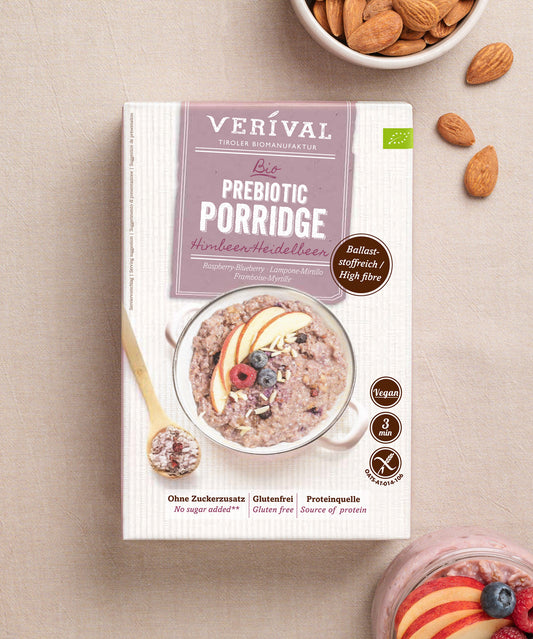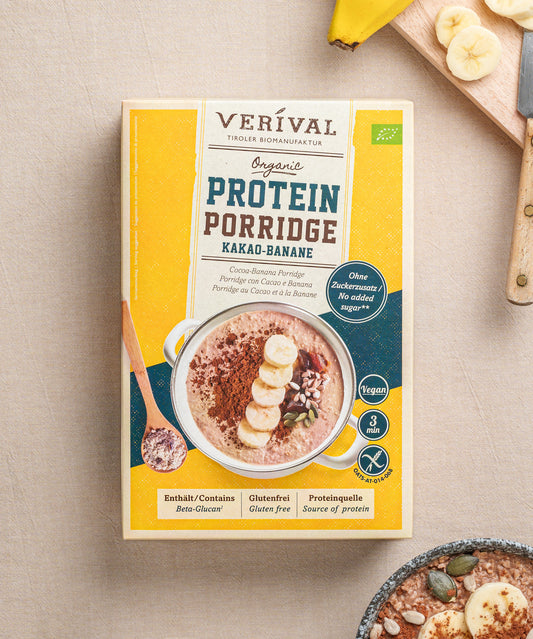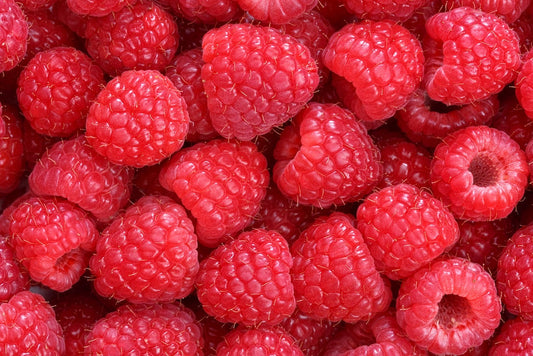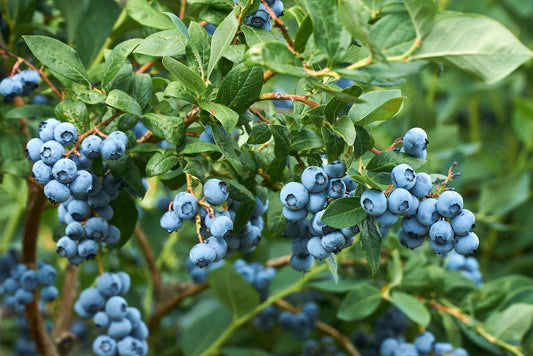Processed foods are everywhere. Most supermarket shelves are full of them – and yet it is common knowledge that processed foods are not necessarily healthy. In this article, you will learn why highly processed products are so popular and how you can recognize them. We will also show you how to make a healthy breakfast even when things are a little more stressful.
What are processed foods?
Food is considered to be processed when it is altered by procedures during the manufacturing process. This can be the removal of inedible parts, the extension of shelf life through preservation methods, or the addition of isolated additives.
The degree of processing can vary depending on how many industrial steps are involved. It starts with unprocessed foods and extends to so-called ultra-processed foods (UPF).
This is how you can have a healthy breakfast even on stressful days – read on
Highly processed food versus ultra-processed food – what are they?
The NOVA system is a very clear classification. It is used in some countries for nutrition guidelines, for example in Brazil and France. The NOVA classification consists of the numbers or groups 1 to 4.
The number “1” indicates that the products are unprocessed or minimally processed foods. The second group stands for processed kitchen ingredients. Group 3 contains processed foods and the number “4” describes highly processed foods.
Unprocessed and minimally processed foods
Unprocessed food belongs to the first group and includes edible parts of plants and animals. These can be seeds, fruits, mushrooms or milk.
Minimally processed foods are products that have been modified by certain processes to remove inedible parts, such as grinding nuts, freezing fruit or placing them in containers for preservation. They also belong in the first group.
Processed cooking ingredients are additionally refined, pressed or crushed to extend their shelf life. Unlike minimally processed products, they are usually not consumed on their own and are usually processed in the kitchen in combination with foods from the first group. Processed cooking ingredients include oils, butters, sugars and salt. They are considered the second group of the NOVA classification.
Find out just how harmful excessive sugar consumption really is
Processed and highly processed foods
The third and fourth groups in the classification are described as processed or highly processed foods.
The third group, i.e. processed foods, usually undergo various preservation or cooking processes. They usually consist of two or three ingredients. The aim of processing is to make the products last longer and to improve their taste. Products in this category include canned fish, cheese, biscuits and vegetables in jars.
Highly processed foods are also referred to as ultra-processed foods. It is difficult to draw a clear line between the two, which is why they are assigned to just one category – group 4.
These are foods such as sweetened soft drinks, savory snacks, ready meals from the freezer section, or composite meat products. They are often a wild combination of table sugar, cheap oils, unhealthy fatty acids, and usually have a high energy density. In addition, artificial or isolated additives are not infrequently added. These are intended to optimize the taste, appearance or even the feeling when eating.
Refined foods have virtually no fiber.
This is the influence of the degree of processing on your health.
As you can see from the fourth group, highly processed foods contain some unhealthy ingredients. But how do they affect health and well-being?
A lot of tricks are used in highly processed foods to maximize the taste experience. However, the ingredients used are anything but healthy. High calorie density, artificial additives, and high amounts of unhealthy fats and sugars are just a small selection. In addition, these products often contain only small amounts of fiber or micronutrients.
All of this is also noticeable physically. This is because the high level of processing increases the stimuli that affect the body. These in turn lead to an altered perception of the taste buds and to changes in brain chemistry. An apple no longer tastes particularly sweet after a sweetened soft drink – and once you've started on a packet of crisps, it's hard to stop.
Natural and lightly processed foods provide you with healthy nutrients.
All of this can be directly or indirectly attributed to the degree of processing. In contrast, unprocessed or lightly processed fruits and vegetables have a lower calorie density and contain plenty of health-promoting ingredients. Fiber, vitamin C and important minerals are just a fraction of what natural foods provide us.
Why are highly processed foods considered unhealthy?
It is therefore not particularly surprising that highly processed foods are considered unhealthy. This is because the increased amounts and combinations of fats, salt and sugar literally make the body addicted. Added to this is the often high energy density.
In fact, the addictive process works very similarly to that of a drug or alcohol addict. The high energy density, for example, leads to an impairment of the reward system. This happens because the body is less sensitive to the reward hormone dopamine. As a result, those affected lack the feeling of reward when eating. This leads to larger portions, more meals and thus often unwanted weight gain. This can negatively affect the metabolism and, in the worst case, lead to cardiovascular diseases.
The additives contained in many ready meals are not generally considered to be particularly healthy either. Although the approved additives are subject to toxicological tests to determine their harmlessness to health, some of the approved additives nevertheless appear to be capable of causing physical problems.
Allergies and intolerances are overestimated in this context – however, so-called pseudoallergies do occur time and again, especially with preservatives and colorants.
Processed foods in a plant-based diet
In many circles, a plant-based diet is considered to be significantly healthier. However, caution is advised when considering a vegan or vegetarian diet to be synonymous with “healthy”. Because even as a vegan or vegetarian, the path to highly processed products is only the path to the nearest supermarket shelf.
Plant-based eating is trendy – and food manufacturers have noticed this too. In recent years in particular, it has been possible to literally observe how the vegan sections in supermarkets have become increasingly full and diverse. Many substitute products for meat, fish and cheese are attracting more and more customers. However, most of the products are highly processed. A quick glance at the ingredients on the back of the packaging usually reveals this.
The vegan sports breakfast from Verival – discover it now
Even in a plant-based diet, it makes sense to choose foods that are as natural as possible and minimally processed. After all, legumes, whole grains, fresh fruit and vegetables provide plenty of healthy nutrients and are also excellent sources of satiety. A tasty bowl of porridge with fresh fruit for breakfast, for example, already offers a healthy combination of health-promoting fiber, vitamins and minerals – and all without unnecessary additives.
How can you recognize highly processed foods?
For many, the question now understandably arises as to how you can recognize highly processed foods. Fortunately, there are some helpful tips and tricks for this.
On the one hand, there are labels on the packaging of the products. The NOVA classification is one of these labels – however, it is not available in all countries. Fortunately, there are even more general clues.
These can be found either on the packaging as a claim – for example “Free from preservatives” or “No artificial colors”. Or you can simply take a look at the back. As is well known, the list of ingredients can be found there, where additives are indicated as E numbers. Examples of this are saccharin, which is listed as E 954, or E 951, better known as aspartame.
Another indication that the food has been heavily processed is an unusually long list of ingredients. The more ingredients listed, the more likely it is that the product has been industrially processed.
For your reference, we have created a short list of products of varying degrees of processing.
| Unprocessed & lightly processed products | Processed & highly processed foods |
| Fruit and vegetables | Salt, sugar and oils |
| Nuts and seeds | Bread, cheese and canned vegetables |
| Oats | Ready meals |
| Milk and eggs | Crisps, chocolate and soft drinks |
| Water and tea | Sausages and sweetened cereals |
You can confidently eat larger quantities of the foods on the left. This is because these products provide you with plenty of healthy nutrients and usually contain no additives. Oats in our muesli and porridge, for example, provide plenty of complex carbohydrates, healthy fiber, and health-promoting minerals and vitamins.
However, you should consume the foods on the right in smaller quantities. In particular, the products listed below, such as crisps, soft drinks, sausage and milk chocolate. These products are highly processed and contain hardly any healthy nutrients – but a good portion of saturated fat, sugar and salt.
Processed but still naturally healthy – Verival
At Verival, we place great emphasis on natural ingredients. Many of our breakfast products therefore contain whole grains, no added sugars and natural sweeteners such as dates or freeze-dried fruits.
It is extremely important to us to avoid adding artificial colors and flavors, to not add preservatives to the products and not to use genetically modified raw materials. We rely on 100% certified organic quality and a balanced distribution of nutrients in all our products. Just one portion of porridge, for example, already covers a third of your daily fiber requirement.
So if you're in a hurry in the morning and don't want to resort to unhealthy ready meals, just reach for our healthy breakfast products in organic quality. Enjoy your meal!
























